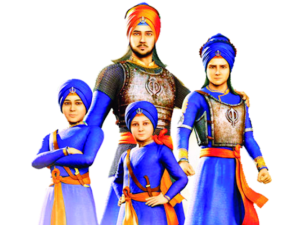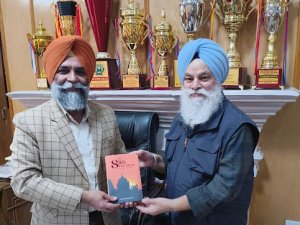The incarnation of Guru Nanak Dev Ji, the manifest Parabrahm form, took place in Bharat-varsha at a time when the condition of the worldly beings was extremely sad and pitiable. Bhavishya Purana, as the name suggests, focuses on the future events. It belongs to Sattva Guna. In this Purana, in the words of Lord Brahma, the virtues of lord Sun are mentioned. It has 129 chapters with 28000 shlokas. In this Purana, a glimpse of thousands of years ago is found about Guru Nanak as follows:
“ਏਵੰਵੈ ਧਰਮ ਪ੍ਰਾਚੁਰਯੰ ਭਵਿੱਖਯਤਿ ਯਦਾ ਕਲੋ ॥੩੩॥ ਤਦੈਵ ਲੋਕ ਰਖਯਾਰਥ ਮਲੇਛਾਨਾ ਨਾਸ਼ ਹੇਤੁਬੇ ॥ ਵਿ ਪਸਚਮੇਤੁ ਸੁਭੇ ਦੇਸ਼ੇ ਬੇਦੀ ਬੰਸੇਚ ਨਾਨਕੋ ਨਾਮਨਾ ॥੩੪॥ ਭੁਵ ਰਾਜ ਰਿਖੀ ਬ੍ਰਹਮ ਗਿਆਨੈਕ ਮਾਨਸ: ॥ ਭਵਿੱਖਤੀ ਕਲਊ ਸਕੰਦ ਤਤ ਬਿਤਯੰ ਕਲਯਾ ਹਰੇ ॥੩੫॥”(ਭਵਿੱਖਤ ਪੁਰਾਣ ਉਤਾਰਧ੍ਰ, 28 ,233-34)
(Meaning: In this way, when the power of religion will be weakening in the near future, when Kalyug will happen, so at that time, for the protection of the people and for the destruction of Malechas in the Bedi clan of the Shubh Desh (Punjab) of the Western direction, Nanak will be the incarnation of a king-sage named Nanak. He will bring knowledge from the Divine and will be his human appearance. He will call forth the conflicts of the coming Kalyug period, the miseries, and kleshas of the living beings of that time.)
Guru Nanak Sahib bestowed the treasure of "Naam" not for any particular sect, but for the salvation of beings of all castes worldwide. Many ancient Muslim saints and mystics have made predictions about his universality, which are present in writings. Pir Wali Niamat Ullah Shah writes in Persian:
ਸ਼ਾਹਿ ਬਾਬਰ ਹੁਕਮਰਾਂ ਬਾਸ਼ਦ ਪਸ ਅਜ਼ ਵੇ ਚੰਦਰੋਜ਼। ਦਰਮਿਆਨਸ਼ ਯਕ ਫ਼ਕੀਰ ਅਜ਼ ਸਾਲਕਾ ਪੈਦਾ ਖ਼ਵੰਦ। ਨਾਮ ਉ ਨਾਨਕ ਬੱਵਦ ਆਰਦ ਜਹਾਂ ਬਾਵੇ ਰਜੂਅ। ਗਰਮ ਬਾਜ਼ਾਰੀ ਫ਼ਕੀਰੀ ਏ ਕਰਾਂ ਪੈਦਾ ਸ਼ਵੰਦ। ਦਰਮਿਆਨਸ਼ ਮੁਲਕ ਪੰਜਾਬ ਸ਼ਵੰਦ ਸ਼ੁਹਰਤ ਤਮਾਮ। ਕੋਮਿ ਸਿੱਖਾਨਿਸ਼ ਮੁਰੀਦੇ ਪੀਰ ਆ ਪੈਦਾ ਸ਼ਵੰਦ। ਕੋਮਿ ਸਿੱਖਾਂ ਅਦਲ ਕਰਦਨ ਬਰ ਰਿਹਾ। ਤਾ ਚੇਹਲ ਇਨਸਾਫ਼ ਈਂ ਅੰਦਰ ਜ਼ਮਾ। ਪਾਂਚ ਸਦੋ ਇਸ਼ਤਾਦੇ ਹਿਜਰੀ ਬੂਦ ਚੂੰ ਈ ਗੁਫ਼ਤਾ ਸ਼ੁਦ। ਯੱਕ ਹਜ਼ਾਰੋ ਸੇ ਸਦੋ ਈਸ਼ਤਾਦ ਈ ਅੰਦਰ ਜ਼ਮਾ।
Niamat Ullah Shah's prognostication regarding Guru Nanak Sahib holds considerable historical and cultural significance. He prophesied that during the reign of Emperor Babur, a remarkable Mystic reformer would emerge in the world. This figure would be none other than Nanak, whose renown would proliferate globally, engendering widespread veneration. Guru Nanak's acclaim would notably flourish in the Punjab region, where his disciples would form the Sikh community, of which he would be the spiritual guide (pir). This Sikh nation was foretold to administer justice equitably among all people and would govern for a duration of forty years.
This saint appeared approximately 547 years before Guru Nanak Sahib. His tomb is said to be on the Somnang mountains in Kashmir. He wrote a prophetic book in Persian about the conditions starting after his death. In this book, he wrote about the conditions from 580 Hijri to 1380 Hijri, covering 800 years. Among them, the following couplet about Guru Nanak Sahib is noteworthy:
Bud Nanak arife mard Khuda.
Raazha-e-marfat jo raah kusha.
Lekin e marde Khuda ahle wafa.
Kird qaumen ke jab hai jaa raha.(The man of God, Nanak, will appear in the latter times.
He will reveal the mysteries that the previous prophets could not unveil.But this man of God will be a person of fidelity.
He will arise when the community is in need.)
This assertion underscores the far-reaching impact and enduring legacy of Guru Nanak's spiritual leadership. The veracity of Niamat Ullah Shah’s foresight is considered pivotal and important in the historical narrative concerning Guru Nanak. These are some of the stories about Satguru Nanak Dev ji, thousands of years before his incarnation, which are not found about any other person in the world.
In many Persian manuscripts, Guru Nanak’s glorious attributes are preserved as:
“Nanak-Panthis are the followers of their Sikh prophets” (Chahar Gulshan,1759-60, Rai Chatarman, Persian MSs no.92, Patna)
“As he (Nanak) had for a long time detached himself from the world and its entanglements,as in the court of God no man’s labor is lost,he attained to the position of a pious divine.” (Imad-u-Sa’adat,1223 A.H, 1808 A.D by Sayyed Ghulam Ali Khan, 1864)
“From his very infancy signs of the manifestation of miracles and divine luster begin to appear in him.And the news of his secret revelations and the realization of the true one spread in the whole world.” (Khalis Namah by Ratan Chand Bal, Persian manuscript no 167, Lahore)
Bhai Gurdas Ji's verses paint a vivid picture of Guru Nanak as a profound spiritual leader whose attributes align closely with those of a prophet. This recognition is deeply rooted in both Sikh and interfaith traditions, reflecting Guru Nanak's universal appeal and his embodiment of prophetic qualities. Guru Nanak, the founder of Sikhism, is revered by various names across different countries and regions, reflecting his widespread influence. The prominent names includes :Punjab: Baba Nanak, Guru Nanak Dev Ji, Nanak Nirankari, Nanak Tapa, Bhutan, Nepal, Sikkim, Tibet: Guru Rinpoche, Guru Nana, Nanak Lama, Southern Tibet: Bhadra Guru, Nepal: Nanak Rishi-Dhomari, Arab Countries: Nanak Pir, Jada, Syria, Kaaba-Mecca, Wali Hind, Russia: Ura Tube, Cairo, Egypt: Nanak Wali, Indo-Turkistan: Guru Nanak Wali, Alkoot and Baghdad Area: Baba Nanak , Baba Nana, Mazar-e-Sharif, Afghanistan: Balgadhan, Bukhara, Russia: Nanak Qalander. These diverse appellations illustrate Guru Nanak's universal appeal and profound spiritual legacy.
According to Bhai Gurdas ji :
Rang Banaras Hinduan, Muslimana Mecca Kaaba. Ghar Ghar Baba Gaviya, Wajan Tal Mrudang Rababa …… Zahar Peer Jagat Gur Baba .
Bābā phir(i) make gaiā nīl bastra dhāre banvārī. Āsā hath(i) kitāb kachh(i) kūjā bāng musalā dhārī. Baithā jāe masīt vich(i) jithai hājī haj(i) gujārī. Jā bābā sutā rāt(i) no val(i) maihrābe pãe pasārī. Jivan(i) mārī lat(i) di kebrā sutā kufr kufārī. Latān val(i) khudāe-de kio kar(i) paiā hoe baj(i)gārī. Tango pakar(i) ghasīția phiria makā kalā dikhārī. Hoe hairān(u) karen(i) juhārī.(32)
(Bābā (Gurū Nanak) then wore blue clothes (like Muslims) and went to Mecca, the holy place of Muslims. He was the personification of God in this garb.He carried a long staff in his hand, a book/notebook under his arm-pit and a prayer mat (musallā) used by the Muslim faithfuls when offering Namāz.He went and sat in the holy mosque where those who came on Hajj were performing their Hajj rituals.As the night fell, Bābā laid down to sleep with his legs and feet extended towards the holy stone (Kābā). A devotee and a religious leader of sort named 'Jiwan' kicked Bābā with his foot and asked who that infidel was sleeping like a cheat and a faithless person.O man! Why are you lying here with your legs extended towards God? Why are you becoming a sinner? Jiwan got hold of Baba's feet and dragged his legs so as to turn them away from the direction of Ka'bā. Bābā showed such divine power so as to turn the holy shrine (Mecca) in the direction his feet were moved to. Bewildered; all present started supplicating before him. (32)
'Prophet' is said to be a great person who has the following four qualities besides other qualities: -
(1) Kitab [religious book] such as Quran Sharif.
(2) Ummat [follower] means, his followers.
(3) "Mu'jizat" (معجزات)(miracles) 'meaning' spiritual power.
(4) Companions [close servants] like Hazrat Muhammad Sahib Ji's four friends - Khalifa Abu Bakr, Khalifa Umar, Khalifa Uthman, Khalifa Ali.
In religious traditions, the title of a prophet is often reserved for those who exhibit distinct qualities. These qualities include possessing a holy book, having a dedicated following (ummah), performing miracles (mojizat), and being surrounded by close companions. Analyzing Guru Nanak's life through these criteria reveals his alignment with these attributes, thereby affirming his prophetic stature.
Kitab (Religious Book): Guru Nanak's hymns and teachings, compiled in the Guru Granth Sahib, serve as the spiritual and doctrinal foundation for Sikhs, akin to how the Quran functions in Islam. His verses are considered divinely inspired and hold a central place in Sikh worship and daily life.
Ummat (Followers): Guru Nanak's following, the Sikh Sangat, has grown from a small group of disciples into a global community. Despite facing historical adversities such as the Mughal rule, invasions by Abdali, and British colonialism, the Sikh community has persevered and flourished, reflecting the enduring strength of their faith.
Mu'jizat (Miracles or Spiritual Power ): Accounts of Guru Nanak's Spiritual Powers /miracles are numerous in Makka Madina and other travels and well-documented as mentioned above . These include the famous incident of the imprint of his hand (panja) on a stone ,Panja Sahib (Hasan abdal) ,In Leh - Ladakh a boulder still bears the indelible marks resembling Guru Ji in a meditative posture. Now known as 'Gurdwara Pathar Sahib.' The transformation of bitter sand into sweet pudding(Hasan Abdal), and the creation of sweet water from a bitter spring . These miracles, though extraordinary, are also seen as manifestations of his spiritual prowess and connection to the divine.
Companions: Just as the Prophet Muhammad had his close companions, Guru Nanak was accompanied by devoted followers such as Baba Buddha ji and Guru Angad Dev Ji (Bhai Lehna). These companions played pivotal roles in the early development of the Sikh faith and were instrumental in continuing Guru Nanak's mission after his death.
Guru Nanak's Unique Position Among Religious Figures
The reverence for Guru Nanak extends beyond the Sikh tradition. He is also honored by Hindus and Muslims, who recognize his spiritual authority and universal message. His interfaith appeal is exemplified in the harmonious coexistence of his Hindu and Muslim followers, even in the face of disputes over his final rites.The respect for Guru Nanak as "Nabi Nanak" or "Wali Allah" highlights the acknowledgment of his prophethood by devout adherents of other faiths. This recognition is further illustrated in the poetic tribute by Alahyar Khan 'Jogi', who celebrated Guru Nanak as a divine emissary sent to guide humanity, transcending religious boundaries.
Historical and Scholarly Perspectives
Pandit Rajji Arya's observations in 'Arya Musafar Masak Patra' provide an additional layer of scholarly endorsement. He notes the alignment of Guru Nanak's life and teachings with the attributes traditionally associated with prophets. This endorsement from a Hindu scholar underscores the universal acknowledgment of Guru Nanak's spiritual significance. Moreover, the reflections of an Iranian woman in Amritsar further validate Guru Nanak's prophetic qualities. She emphasizes that while many prophets are recognized within their respective traditions, Guru Nanak uniquely embodies all prophetic attributes and is revered by non-Muslims as well, underscoring his universal and inclusive spirituality. When I consider Baba Nanak, it becomes unmistakably evident that he embodies these four elements:
Baba Nanak Kitab Darad, Baba Nanak Ummat Darad, Baba Nanak Mu'jizat Darad, Baba Nanak Companions Darad.
Elderly Muslims, filled with spiritual fervor and conviction, acknowledge this. Therefore, without doubt and with good fortune, Baba Nanak is recognized as a prophet.
Conclusion
Guru Nanak's life and teachings resonate with the characteristics of a prophet, as evidenced by the reverence he commands across different religious traditions. His contributions to spiritual discourse, his miraculous deeds, and the enduring strength of the Sikh community all affirm his prophetic stature. In this light, Guru Nanak can be seen not only as the founder of Sikhism but also as a universal prophet whose message transcends religious and cultural boundaries.







